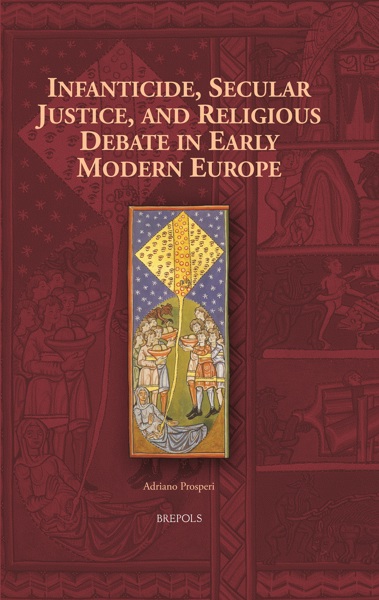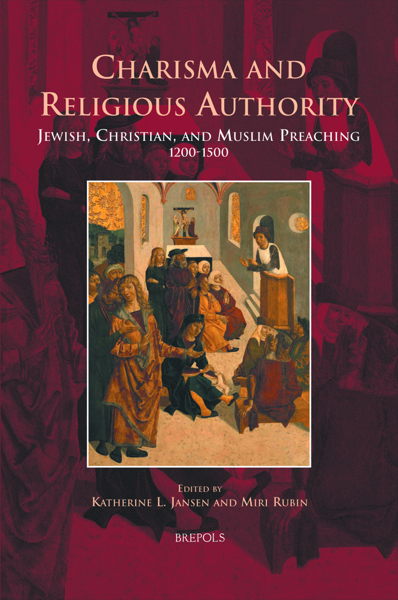
Faith’s Boundaries
Laity and Clergy in Early Modern Confraternities
Nicholas Terpstra, Adriano Prosperi, Stefania Pastore (eds)
- Pages: 396 p.
- Size:156 x 234 mm
- Illustrations:12 b/w
- Language(s):English, Latin
- Publication Year:2013
- € 120,00 EXCL. VAT RETAIL PRICE
- ISBN: 978-2-503-53893-8
- Hardback
- Available
- € 120,00 EXCL. VAT RETAIL PRICE
- ISBN: 978-2-503-55818-9
- E-book
- Available
This volume explores how the relationship between confraternities and the clergy negotiated the boundaries of religious space in the late medieval and early modern periods.
"(...) the volume is a valuable contribution to the scholarly study of the confraternities in general and of lay-clerical relations in particular. Much of the material is fresh from the archives, and thus immensely helpful to specialists." (Max Harris, in: Sixteenth Century Journal, Vol. XLV/4, 2014, p. 1044)
“Many of the contributions in this volume are close, convincingly argued interpretations of archival material. As a collection, they lay groundwork that will be of interest to researchers of confraternal studies and lay devotion more generally.” (Kathleen Olive, in Parergon, 33/1, 2016, p. 249)
Who owns the spaces of religion? Does the question matter, or even make sense? Modern distinctions between sacred and secular spheres tend to assume that clergy dominate the former, and lay people the latter. A man or woman living in the early modern period might not have been so sure. They would have thought more immediately of things of heaven and things of earth, and would have seen each as the concern of clergy and laity alike. Faith’s boundaries, while real, were very porous. This collection offers the first sustained comparative examination of lay–clerical relations in confraternities through the late medieval and early modern periods. It shows how laity and clergy debated, accommodated, resolved, or deflected the key issues of gender, race, politics, class, and power. The sixteen essays are organized into six sections that consider different aspects of the function of confraternities as social spaces where laity and clergy met, mediated, and sometimes competed and fought. They cover a period historically when kinship was a dominant metaphor in religious life and when kinship groups like confraternities were dominant models in religious institutions. They deal with Catholic, Jewish, and Islamic confraternities, and range geographically from Europe to the Middle East, Central and South Asia, and Latin America.
Boundaries of Brotherhood: Laity and Clergy in the Social Spaces of Religion — NICHOLAS TERPSTRA
Part I. Confraternities and Comunitas: Politics, Charity, and Civic Religion
Civic Hospitals, Local Identity, and Regional States in Early Modern Italy — DANIEL BORNSTEIN
Delegated Charity: Confraternities between City, Nations, and Curia in Late Medieval Rome — ANNA ESPOSITO
Confraternities, Citizenship, and Factionalism: Genoa in the Early Sixteenth Century — CARLO TAVIANI
Between Devotion and Politics: Marian Confraternities in Renaissance Parma — CRISTINA CECCHINELLI
Part II. Texts & Contexts: The Case of Florence
The Plea for Lay Bibles in Fourteenth- and Fifteenth-Century Tuscany: The Role of Confraternities — SABRINA CORBELLINI
Preaching, Brotherhoods, and Biblical Literacy: The Case of Pietro Bernardo of Florence — PETER HOWARD
Machiavelli and Confraternities: Oratory and Parody — OLGA ZORZI PUGLIESE
Part III. Kinship, Civil Society, and Social Capital
Bonding or Bridging Social Capital? The Evolution of Brabantine Fraternities during the Late Medieval and the Early Modern Period — MAARTEN F. VAN DIJCK
Negotiating Charity, Politics, and Religion in the Colonial Philippines: The Brotherhood of the Misericordia of Manila (1594–1780s) — JUAN O. MESQUIDA
Part IV. Kinship and the Politics of Devotion in Islam and Judaism
Islamic Brotherhoods in Sixteenth‑Century Central Asia: The Dervish, the Sultan, and the Sufi Mirror for Princes — ALEXANDRE PAPAS
Kabbalistic Innovation in Jewish Confraternities in the Early Modern Mediterranean — RONI WEINSTEIN
Part V. Mediating Difference: Race, Gender, and Kinship
Confraternal Community as a Vehicle for Jewish Female Agency in Eighteenth-Century Italy — FEDERICA FRANCESCONI
Native Brotherhoods and Visual Culture in Colonial Quito (Ecuador): The Confraternity of the Rosary — SUSAN VERDI WEBSTER
Part VI. Boundary Disputes:Laity, Clergy, and Conflict
Revolutionary Flagellants? Clerical Perceptions of Flagellant Brotherhoods in Late Medieval Flanders and Italy — GAVIN HAMMEL
Beyond Crisis: Confraternities in Modern Italy between the Church and Lay Society — DANILO ZARDIN
‘Such a despotic rule’: Confraternities and the Parish in Eighteenth-Century Paris and Milan — DAVID GARRIOCH




